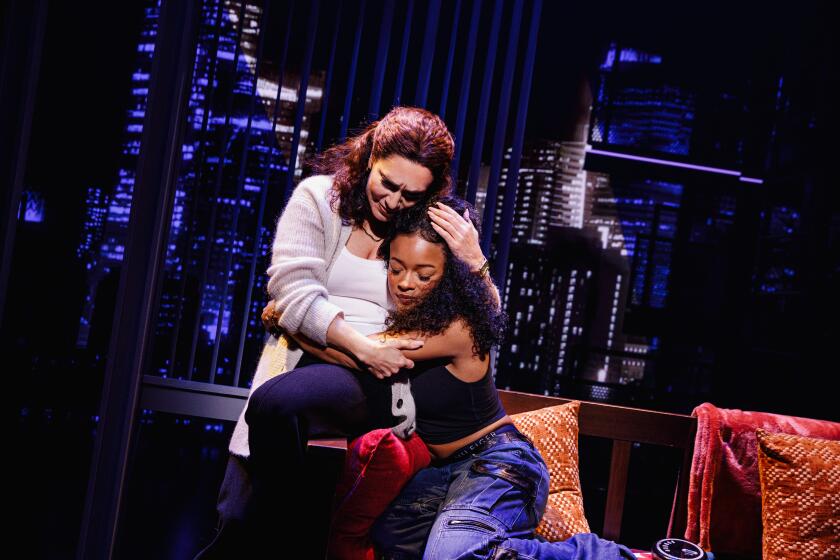An Art Lover Who Liked to ‘Buy Nice Things and Swap’
When I met Billy Wilder, nearly 13 years ago, he was brimming with life and wicked wit, but death was on his mind. As we sat and chatted in his second-floor office on Brighton Way in Beverly Hills, he told me that he was planning to sell his renowned collection of modern and contemporary art because he was confronting his own mortality.
“The moment comes when you suddenly realize that friends who were collectors have died, and the widow, the children and maybe a new husband are having all this fun at an auction. I want to be alive while that auction is going on. I want to get that kick,” he said, at the age of 83.
For the record:
12:00 a.m. March 30, 2002 FOR THE RECORD
Los Angeles Times Saturday March 30, 2002 Home Edition Main News Part A Page 2 A2 Desk 3 inches; 73 words Type of Material: Correction
Billy Wilder photos--Credits were inadvertently omitted from photos published with Friday’s Section A obituary and story on director Billy Wilder. The photos should have been credited as follows: Wilder with Jack Lemmon, Kobal Collection; with Gloria Swanson, Kobal Collection; with Gina Lollobrigida, Copyright A.M.P.A.S.; with his wife Audrey, Reuters; with one of his paintings, Los Angeles Times. The photo of Marilyn Monroe in Wilder’s “Seven Year Itch” was incorrectly credited. It was from 20th Century Fox.
Then he regaled me with anecdotes about the artworks he intended to put on the market. “My God, what a waste,” he said of Fernando Botero’s painting of a plump nude woman standing in a bathtub. “Giacometti could have made three figures with that, and there still would have been enough left over for one small William Morris agent.”
As usual, Wilder’s timing was impeccable. His collection brought a whopping $32.6 million at Christie’s New York on Nov. 13, 1989--just a few months before the art market collapsed. He got his “kick” seated near the front of the jampacked sale room as seven works were sold for more than $1 million apiece and record prices were established for a dozen artists. When the crowd dispersed, he said the dramatic event was “less nerve-racking than a film preview,” hailed a taxi and disappeared into the Park Avenue traffic.
But not for long. He was an inveterate collector who couldn’t stifle his interest in art any more than he could quell his passion for the kind of “pictures” that made him famous. He started collecting Toulouse-Lautrec posters in the late 1920s in Germany and got going in earnest in the 1930s, after he fled to America and started putting money aside for art purchases.
“My good luck in all those years was that I never bought racehorses, I never had a yacht, I never bought a Ferrari,” he said. “I have no villa in St. Tropez, I cut down on my ballooning in Bavaria and I stayed away from junk bonds. I just buy nice things and swap.”
He wasn’t an easy mark, however. Recently, when his longtime friend dealer Louis Stern tried to interest him in an early Picasso drawing, Wilder responded, “Early, middle, late, what do I care?” Taking another tack, Stern showed him the drawing’s back side, covered with notations on its distinguished history of ownership. Lowering his head and peering over the rims of his glasses, Wilder said, “Look how many people didn’t want it.”
His taste in art was eclectic but veered toward piquant Expressionism, explicit sexuality and spicy humor. This was especially clear when he collaborated with artists who developed his ideas.
On one memorable occasion in late 1993, he curated an exhibition at Stern’s former gallery in Beverly Hills. The show included a series of painted sculptures that he dreamed up with artist Bruce Houston. Called “Variations on the Theme of Queen Nefertete II” and executed in the styles of famous modern and contemporary artists, the sculptures are takeoffs on a historic bust of the Egyptian queen that Wilder admired as a youth at the Berlin State Museum.
In 2000, Wilder’s artistic taste went public again, at Christie’s in Beverly Hills in an auction of modestly priced art, furniture and memorabilia from his collection, which brought a total of about $2 million. “I’m just closing up before checking out,” he said before the sale. But not completely. He couldn’t part with a drawing of his director’s chair by David Hockney, one of his favorite artists.
Even as Wilder’s health declined and he complained bitterly about impairments to his hearing and eyesight, he had a zest for life. He loved lunching with friends at Mr. Chow and Matsuhisa, after a few glasses of very good sake. When I asked him to sign copies of Cameron Crowe’s book “Conversations With Wilder” for his admirers at The Times, he seemed surprised but pleased that relatively young people still revere his work.
One of the last times I saw Wilder was at the Norton Simon Museum in Pasadena. From 1979 to 1990, he served on the board of trustees of two foundations that support the museum, but he hadn’t seen the renovation of the facility that was completed in 1999. He was nearly speechless when Simon’s widow, actress Jennifer Jones Simon, greeted him, and director of art Sara Campbell conducted a brief tour. After he had taken it all in, he gave the Wilder seal of approval in a single word, “Wonderful.”
The most memorable lines in Wilder’s films often reflect his caustic assessment of human frailties. But the words I’ll remember are those he uttered with increasing frequency toward the end of his life: “God bless you.”
That phrase served many purposes for Wilder, from heartfelt thanks and good wishes to polite dismissals of strangers who showered him with compliments. To me, Wilder’s “God bless you” signified the soft side of a prickly genius.
More to Read
The biggest entertainment stories
Get our big stories about Hollywood, film, television, music, arts, culture and more right in your inbox as soon as they publish.
You may occasionally receive promotional content from the Los Angeles Times.






